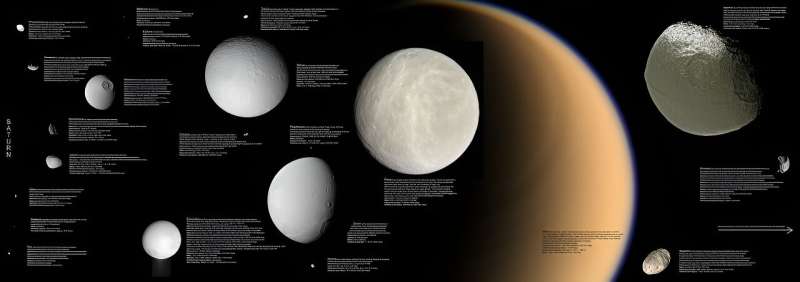
Saturn is best known for two things: its iconic ring structures and its large system of natural satellites. Currently, 146 moons and moonlets have been discovered orbiting the ringed giant, 24 of which are regular satellites. These include the seven largest moons, Titan, Rhea, Iapetus, Dione, Tethys, Enceladus, and Mimas, which are icy bodies believed to have interior oceans.
In addition, there are unresolved questions about the age of these satellites, with some suspecting that they formed more recently (like Saturn’s rings, which are a few hundred million years old).
To address these questions, an international team of astronomers created a series of high-resolution simulations coupled with improved estimates of trans-Neptunian object (TNO) populations.
This allowed them to construct a chronology of impacts for Saturn’s most heavily cratered regular satellites—Mimas, Enceladus, Tethys, Dione, and Rhea. This established age limits of 4.1 and 4.4 billion years for all five, with the two innermost moons appearing more youthful than the outer three. These results could have significant implications for our understanding of the formation and tidal evolution of moons in the outer solar system.
The research was led by Emily Wai Wong, a researcher with the Earth-Life Science Institute (ELSI) at the Tokyo Institute of Technology. She was joined by Ramon Brasser, an associate professor at the ELSI and the Origins Research Institute at the Research Center for Astronomy and Earth Sciences (ORI-RCAES), Stephanie C. Werner, the deputy director of the Center for Planetary Habitability (PHAB) at the University of Oslo, and lead research scientist Michelle R. Kirchoff of the Southwest Research Institute (SwRI).
Their paper, “Saturn’s ancient regular satellites,” appeared in the journal Icarus.
Since sample-return missions have not yet been sent to the Saturn system, obtaining accurate ages for its satellites is very difficult. In lieu of radiometric dating samples, Wong and her team turned to establishing a crater chronology of these satellites.
By dating impact craters on the surface, some general constraints can be established for how long these moons have been around. The first step in this process was to model cratering rates in the outer solar system, where the migration of the giant planets led to periods of bombardment by displaced TNOs and other objects.
In a previous study, Wong and her colleagues conducted a timeline simulation of the outer solar system starting from the onset of giant planet migration, which they set at 4.5 billion years ago. They then used predictive Monte Carlo simulations to determine the expected crater densities, assuming two different size-frequency distributions of TNOs encountering the giant planets and their satellites. These were combined to derive surface ages for the most heavily cratered satellites of Jupiter, Saturn, and Uranus, ranging from 3.8 to 4.4. billion years.
Unfortunately, these and other previous simulations suffered from poor resolutions for the last 3.5 billion years because of a limited number of planetesimals in their simulations. This prevented them from obtaining accurate ages of satellites with low crater densities (like Enceladus), and the ages derived showed significant variation based on the two different sizes of TNOs. As they note in their paper:
“In this work, we obtained a more accurate crater chronology onto the icy regular satellites that can be applied to the whole history of the solar system. We computed model surface ages for said satellites for various crater diameters from age isochrons similar to those that exist for the moon and Mars in the inner solar system. We applied this new chronology to the inner Saturnian satellites to compute more accurate model surface ages of their most densely cratered surfaces.”
From this, they computed new ages for Saturn’s regular satellites, which were approximately 110 to 300 million years older than previous estimates obtained by Wong and colleagues. The age estimates they obtained from this study for the cratered plains on Mimas and Enceladus were 4.16 Ga and 4.10 Ga (respectively), while those for Tethys, Dione, and Rhea were around 4.4 Ga—with uncertainties of about 300 million years. As they wrote, they also noted an interesting pattern with these estimates:
“Regardless of the approach used, the surface ages of the satellites generally follow a pattern of increasing age with increasing orbital distance, except Mimas and Enceladus: these two inner and smaller satellites are reversed, and their surfaces are around 200 million years younger than those of Tethys, Dione, and Rhea.”
These results imply that Saturn’s regular satellites are old, which has implications for their formation and tidal evolution. The techniques they employed are also applicable to satellites of Jupiter, Uranus, and possibly Neptune, allowing astronomers to learn a great deal about the evolution of these planets, their satellites, and the history of the solar system.
More information:
E.W. Wong et al, Saturn’s ancient regular satellites, Icarus (2023). DOI: 10.1016/j.icarus.2023.115763. On arXiv: DOI: 10.48550/arxiv.2309.03861
Provided by
Universe Today
Whether Saturn’s rings are young or old, its moons may be as ancient as the planet itself (2023, September 14)
retrieved 27 September 2023
from https://phys.org/news/2023-09-saturn-young-moons-ancient-planet.html
part may be reproduced without the written permission. The content is provided for information purposes only.